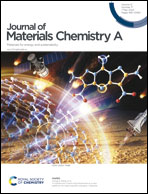FeHS vacancies in a Prussian white cathode leads to enhanced FeLS activity and electrode kinetics for boosted K+ storage†
Abstract
Fe-based Prussian white (PW) is considered a superior cathode material for potassium-ion batteries (PIBs) because of its three-dimensional open framework structure, high potassium content, and low cost; however, a dramatic distortion of low-spin (LS) Fe–C octahedra typically occurs upon the extraction of second K+, leading to a deteriorated structure as well as poor rate and cycling performance, thus limiting their practical applications. In this work, FeHS vacancies were successfully incorporated into the lattice structure of PW by simply controlling synthesis temperatures in the presence of the chelating agent potassium citrate, which was confirmed by a series of structural characterizations. A low reaction temperature is found to suppress the incorporation of Fe into the PW structure and therefore leads to the formation of more FeHS vacancies. As a result, a sample synthesized at the lowest temperature (0 °C) exhibits a more prominent charge–discharge plateau at a high potential region that corresponds to the enhanced activity of FeLS and best K+ storage properties, including a reversible capacity of 117.2 mA h g−1 at a current rate of 30 mA g−1, 80.7% capacity retention at 10C after 1000 cycles, and excellent rate capability. Kinetic analysis and impedance spectroscopy clearly revealed enhanced charge transfer/ion diffusion and a stable host structure upon cycling for the samples synthesized at lower temperatures, further demonstrating the critical role of FeHS vacancies for efficient K+ storage. In general, this work provides an efficient and simple strategy to create cation vacancies in the PW cathode, which enables the development of high-performance potassium-ion batteries and can be extended to other related energy storage systems.



 Please wait while we load your content...
Please wait while we load your content...